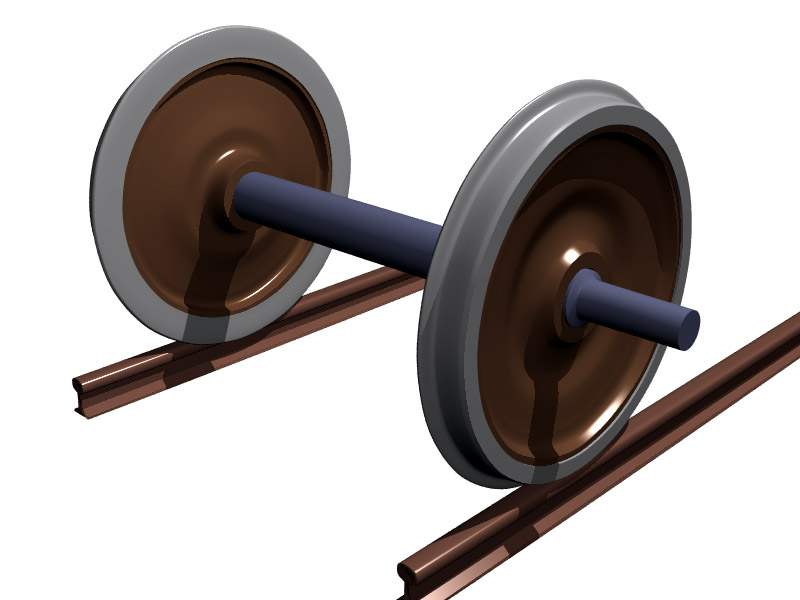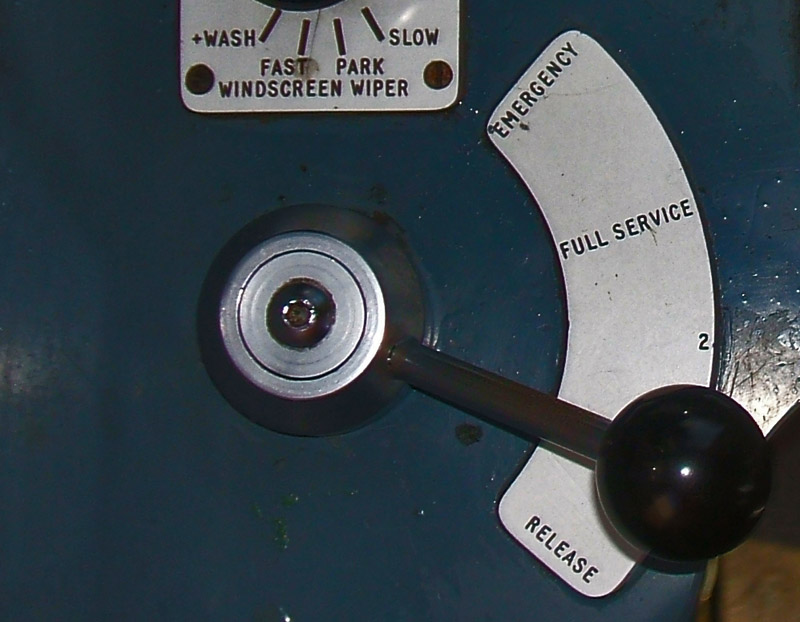|
Counterweight Brake
A counterweight brake () is an early form of hand brake on railway tenders and tank locomotives. By throwing a counterweight lever, play in the brake blocks is quickly taken up and braking action is initiated. Further movement of the lever increases the transmission so that the blocks are pressed against the wheel tyres with greater and greater force. On locomotive tenders the counterweight brake generally acts on all the axles, whilst on tank engines the braking action is only applied to the driving and coupled wheels. See also * Emergency brake (train) On trains, the expression emergency brake has several meanings: * The ''maximum'' brake force available to the engine driver from the conventional braking system, usually operated by taking the brake handle to its furthest position, through a ga ... * - to follow Literature * ''Lexikon Eisenbahn'', Transpress Verlag für Verkehrswesen, Berlin, 1978 Railway brakes {{rail-transport-stub ... [...More Info...] [...Related Items...] OR: [Wikipedia] [Google] [Baidu] |
Railway Brake
A railway brake is a type of brake used on the cars of railway trains to enable deceleration, control acceleration (downhill) or to keep them immobile when parked. While the basic principle is similar to that on road vehicle usage, operational features are more complex because of the need to control multiple linked carriages and to be effective on vehicles left without a prime mover. Clasp brakes are one type of brakes historically used on trains. Early developments In the earliest days of railways, braking technology was primitive. The first trains had brakes operative on the locomotive tender and on vehicles in the train, where "porters" or, in the United States brakemen, travelling for the purpose on those vehicles operated the brakes. Some railways fitted a special deep-noted brake whistle to locomotives to indicate to the porters the necessity to apply the brakes. All the brakes at this stage of development were applied by operation of a screw and linkage to brake bl ... [...More Info...] [...Related Items...] OR: [Wikipedia] [Google] [Baidu] |
Railway Tender
A tender is a special rail vehicle hauled by a steam locomotive containing its fuel (wood, coal, oil or torrefied biomass) and water. Steam locomotives consume large quantities of water compared to the quantity of fuel, so their tenders are necessary to keep them running over long distances. A locomotive that pulls a tender is called a tender locomotive. Locomotives that do not have tenders and carry all their fuel and water on board are called ''tank locomotives'' or ''tank engines''. A corridor tender is a locomotive tender with a passageway to one side, allowing crew changes on the fly. A brake tender is a tender that is heavy and used (primarily) to provide greater braking efficiency. General functions The largest steam locomotives are semi-permanently coupled by a drawbar to a tender that carries the water and fuel. The fuel source used depends on what is economically available locally. In the UK and parts of Europe, a plentiful supply of coal made this the obvious cho ... [...More Info...] [...Related Items...] OR: [Wikipedia] [Google] [Baidu] |
Tank Locomotive
A tank locomotive is a steam locomotive which carries its water in one or more on-board water tanks, instead of a more traditional tender (rail), tender. Most tank engines also have Fuel bunker, bunkers (or fuel tanks) to hold fuel; in a #Tender-tank, tender-tank locomotive a tender holds some or all of the fuel, and may hold some water also. There are several different types of tank locomotive, distinguished by the position and style of the water tanks and fuel bunkers. The most common type has tanks mounted either side of the boiler. This type originated about 1840 and quickly became popular for industrial tasks, and later for Shunting (rail), shunting and shorter-distance Main line (railway), main line duties. Tank locomotives have #Advantages and disadvantages, advantages and disadvantages compared to traditional locomotives that required a separate tender to carry needed water and fuel. History Origins The first tank locomotive was the Novelty (locomotive), ''Novelty ... [...More Info...] [...Related Items...] OR: [Wikipedia] [Google] [Baidu] |
Brake Block
A railway brake is a type of brake used on the cars of railway trains to enable deceleration, control acceleration (downhill) or to keep them immobile when parked. While the basic principle is similar to that on road vehicle usage, operational features are more complex because of the need to control multiple linked carriages and to be effective on vehicles left without a prime mover. Clasp brakes are one type of brakes historically used on trains. Early developments In the earliest days of railways, braking technology was primitive. The first trains had brakes operative on the locomotive tender and on vehicles in the train, where "porters" or, in the United States brakemen, travelling for the purpose on those vehicles operated the brakes. Some railways fitted a special deep-noted brake whistle to locomotives to indicate to the porters the necessity to apply the brakes. All the brakes at this stage of development were applied by operation of a screw and linkage to brake blo ... [...More Info...] [...Related Items...] OR: [Wikipedia] [Google] [Baidu] |
Axle
An axle or axletree is a central shaft for a rotation, rotating wheel and axle, wheel or gear. On wheeled vehicles, the axle may be fixed to the wheels, rotating with them, or fixed to the vehicle, with the wheels rotating around the axle. In the former case, bearing (mechanical), bearings or Bushing (bearing), bushings are provided at the mounting points where the axle is supported. In the latter case, a bearing or bushing sits inside a central hole in the wheel to allow the wheel or gear to rotate around the axle. Sometimes, especially on bicycles, the latter type of axle is referred to as a ''spindle (tool), spindle''. Terminology On cars and trucks, several senses of the word ''axle'' occur in casual usage, referring to the shaft itself, its housing, or simply any transverse pair of wheels. Strictly speaking, a shaft that rotates with the wheel, being either Bolt (fastener), bolted or rotating spline, splined in fixed relation to it, is called an ''axle'' or ''axle shaft ... [...More Info...] [...Related Items...] OR: [Wikipedia] [Google] [Baidu] |
Driving Wheel
On a steam locomotive, a driving wheel is a powered wheel which is driven by the locomotive's pistons (or turbine, in the case of a steam turbine locomotive). On a conventional, non-articulated locomotive, the driving wheels are all coupled together with side rods (also known as coupling rods); normally one pair is directly driven by the main rod (or connecting rod) which is connected to the end of the piston rod; power is transmitted to the others through the side rods. On diesel and electric locomotives, the driving wheels may be directly driven by the traction motors. Coupling rods are not usually used, and it is quite common for each axle to have its own motor. Jackshaft drive and coupling rods were used in the past (e.g. in the Swiss Crocodile locomotive) but their use is now confined to shunter locomotives. On an articulated locomotive or a duplex locomotive, driving wheels are grouped into sets with wheels within each set linked together. Diameter Drivin ... [...More Info...] [...Related Items...] OR: [Wikipedia] [Google] [Baidu] |
Coupled Wheel
On a steam locomotive, a driving wheel is a powered wheel which is driven by the locomotive's pistons (or turbine, in the case of a steam turbine locomotive). On a conventional, non-articulated locomotive, the driving wheels are all coupled together with side rods (also known as coupling rods); normally one pair is directly driven by the main rod (or connecting rod) which is connected to the end of the piston rod; power is transmitted to the others through the side rods. On diesel and electric locomotives, the driving wheels may be directly driven by the traction motors. Coupling rods are not usually used, and it is quite common for each axle to have its own motor. Jackshaft drive and coupling rods were used in the past (e.g. in the Swiss Crocodile locomotive) but their use is now confined to shunter locomotives. On an articulated locomotive or a duplex locomotive, driving wheels are grouped into sets with wheels within each set linked together. Diameter Driving wheels ... [...More Info...] [...Related Items...] OR: [Wikipedia] [Google] [Baidu] |
Emergency Brake (train)
On trains, the expression emergency brake has several meanings: * The ''maximum'' brake force available to the engine driver from the conventional braking system, usually operated by taking the brake handle to its furthest position, through a gate mechanism, or by pushing a separate plunger in the cab. * A completely separate mechanism from the conventional braking system, designed to stop the train as quickly as possible. * A handle or plunger which may be applied by a passenger in an emergency, either stopping the train directly or sending an alarm to the driver so that they can stop the train. Industry vernacular for when the emergency brake is applied is go into emergency, as in phrases like "the train may fail to go into emergency" or "the ability of the train to go into emergency is paramount". The emergency brake applies considerably more braking force than the standard full-service brake. The engine driver or motorman will only use the emergency brake as a last resort, s ... [...More Info...] [...Related Items...] OR: [Wikipedia] [Google] [Baidu] |





